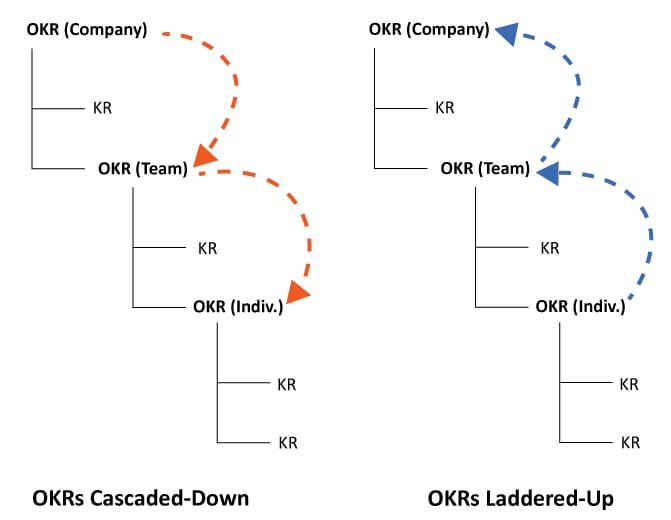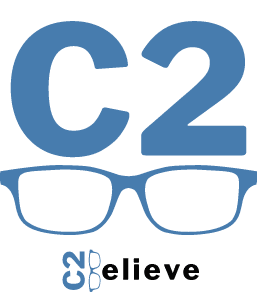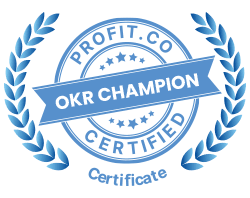Listen and follow
Introduction
In a previous post, “Are OKRs only for top level management?”, we lamented that OKRs were being applied mostly at the executive and team levels, not at the individual level. Even though OKRs are presented as a company-wide, culture-changing management framework, individual OKRs are being shelved for various reasons.
In this article, we make a stronger case for the importance of individual OKRs.
New to OKRs, see “What is OKR?”。
What is an Individual OKR?
Individual OKRs cascaded-down, laddered-up, and developmental.
In the world of OKRs, there are Company OKRs, Team OKRs and Individual OKRs. Typically, the big picture Company OKRs (goals) are created at the top – then the Key Results may be assigned to Teams (or Depts) and become Team OKRs themselves. The Key Results from Team OKRs may be assigned to Individuals and become an Individual OKR. That’s called cascaded-down OKR.
Sometimes a Team will create new OKRs to help out an upper-level company OKR, and that’s called laddered-up OKR. Individuals can also ladder-up their own Individual OKRs to upper Team Level OKRs.

I will call a third type Individual OKR the Developmental OKRs which are OKRs to improve individual skills to help raise the bar for the Team or Company (e.g. improve Excel Skills, study Digital Marketing, learn a new Sales Strategy).
Google practices Individual OKRs.
At Google, all staff are required to submit their Individual OKRs for the upcoming quarter. These are the Objectives and the Key Results that determine their most important work for the period.
Some companies follow Google’s lead and try to implement company-wide OKRs only to run into problems at the Individual levels.

Problems with Individual OKRs
Ben Lamorte, in “The OKRs Field Book”, reports that some Googlers found individual OKRs very helpful, while others found it a waste of time.
Lamorte also states these problems:
- Some staff will “Sandbag” or “low-ball” their OKR efforts, setting goals deliberately conservative to ensure easy achievement.
- Staff will state their OKRs as just a list of tasks, not a list of measurable goals. When you list tasks, it’s project management, not OKR goal-setting.
- Individual OKRs are seen as a compliance order from top management
Lamorte’s conclusion was that OKRs should be optional at the individual level – but if it is, I think that most would choose not to practice optional OKRs (see 10-80-10 principle discussed later).
Problem is not Individual OKRs – It’s OKR implementation
If you are going to force all employees to submit their own OKRs every quarter, of course you are going to run into problems. It’s hard enough to get managers to write proper OKRs, let alone hundreds of front-line staff members. OKRs are nuanced and require careful training and implementation.
OKR “sandbagging” or “task listing” problems should never happen.
OKRs, no matter team or individual, should never be done in a vacuum – OKR managers review and negotiate the OKRs with the individual to make sure:
- “Sandbagging” is discouraged, and “Stretch” encouraged.
- Staff are coached on the difference between Key Results and Tasks.
- OKR is aligned to team or company mission or visions.
- OKRs along with BAU (Business as Usual) can fit into their quarterly schedule.
- OKRs are not tied to annual performance reviews.
This Conversation, Feedback and Recognition (CFR) between managers and staff is one of the important aspects of OKRs to mitigate these problems.
If OKRs are not being properly written, it should be more a reflection about the manager, not the individual. Writing good OKRs requires patience and good coaching.
OKR Master and OKR Coaches are crucial.
If you want to eventually deploy OKR throughout your organization, you need to identify OKR evangelists (or advocates) in your company – This might include an OKR master, responsible for the coordination of deployment, and the perpetuation of OKR ideology.
Also, OKR coaches are important to train managers on how to implement OKR into their team environments.
How to approach Individual OKRs for staff
When you ask a front-line staff member to write down their OKRs for the quarter, what are they supposed to consider? This is where staff feel lost because it’s usually the manager telling them what to do.
So staff members can start by asking themselves these questions.
- Do I have any cascaded OKRs?
- Do I have any OKRs that are lattered-up?
- Do I have any carry-over OKRs from the last quarter?
- Do I want to boost my skills for the team? – Developmental OKRs
- Are my OKRs stretched? Are my Key Results quantifiable?
- Can I fit them into my quarterly schedule?
This will give staff some much-needed guidelines when creating their own OKRs.
Executives and Managers need to walk-the-talk.
If the top levels of management are not committed to their own Individual OKRs, you can’t expect any of your staff to be.
In the book “Measure what Matters”, John Doerr states:
“Now CEO of Alphabet, Larry (Page) sees to it that OKRs are used at the parent company’s other subsidiaries. And he still writes his own individual OKRs each quarter.”
In the companies I consulted with in Taiwan, CEO and Executives feel exempt from writing their own OKRs – but if anyone needs to have goals, it’s upper management – and if they can’t commit with their own OKRs, why should anyone else?
Writing Key Results are not immediately intuitive.
When handed down an objective, we are used to just drawing up all the tasks to reach that goal. But writing a Key Result as a measurable, trackable outcome doesn’t come naturally to most of us. Perhaps this is what some Googlers found a “waste of time”.
Writing Key Results this way seems reasonable, but let’s be practical – sometimes it’s silly to take an hour brainstorming ways to transform a simple task into a quantifiable outcome.
The famous “Orange Crush” OKR at Intel had 3 out of 4 KRs that were not measurable.
Intel Orange Crush OKR.
Objective:
Establish the 8086 as the highest performance 16-bit microprocessor family, as measured by:
Key Results:
- Develop and publish five benchmarks showing superior 8086 family performance (Applications) (Q2 1980).
- Repackage the entire 8086 family of products (Marketing).
- Get the 8MHz part into production (Engineering, Manufacturing).
- Sample the arithmetic coprocessor no later than June 15 (Engineering).
The last 3 Key Results are not Quantifiable.
From “Measure What Matters” by J. Doerr
Of course, you should try to write Key Results as quantifiable units because they are objective, incontrovertible outcomes that no one can argue with.
However, you should still avoid writing task lists under an OKR objective. If you have many tasks you want to list, assign them to an “Initiative”, which can have as many tasks as you want – you are now going from OKR to Project Management, and indeed, the lines are blurred.
Read about Initiatives here “What is OKR in Project Management”。
Don’t expect Individual OKRs to work right away.
OKRs are an iterative process of trying, failing, improving – If a staff member always achieves their OKRs, they need to “stretch” more. If a staff member always fails their OKRs, they may not have the appropriate training or facilities to succeed.
As a manager, you help your staff establish appropriate objectives, including proper preparation, and finding that sweet spot between too much and too little.
OKRs, in principle, are not so obsessed with failure as long as you retrospect, adjust and improve for the next cycle.
You don’t need to deploy Individual OKRs across a company right away.
A CEO doesn’t have to manage OKRs for all 400 people in a company. Nor does a department executive need to manage 100 OKRs for their group. The hierarchy of goals in an OKR chart only requires you to keep an eye on those OKRs directly beneath you, which should only be about 3-5 OKRs. And that’s the beauty of OKRs – you can optionally drill down for details, and yet collapse details for clarity.
Furthermore, you don’t have to implement across the board all at once. You can start with Corporate OKRs, and select one or two teams to pilot those OKRs. The success of these teams will encourage other parts of the company to naturally catch on to OKRs.
Individual OKRs raise the bar for teams.
I’ve worked with several Tech Companies in Taiwan, where staff members will wait to be told what to do by their managers – there is a lack of individual ambition or initiative.
Subsequently, managers spend too much time on staff administration, scheduling and issue resolution – there’s no time for anything else. It’s a common problem in top-down companies.
Individual OKRs teach each staff member how to set goals, plan, track progress and achieve. In effect, OKR has everyone “managing”, leaving their own managers more time for other important things.
10-80-10 Principle proposes there’s a lot of untapped potential.
In the book “Above the Line” by championship college football coach Urban Meyer, he mentions the 10-80-10 principle and states that in an organization:
- Top 10 percent of people are self-disciplined and strive for self-improvement.
- Middle 80 percent are diligent and trustworthy but lacks drive.
- Bottom 10 percent resist, defy and are generally disengaged.
It means that in an organization, 80% of the staff have the potential to improve their capabilities with the proper motivation – But this 80% will not proactively create aspirational OKRs on their own (lacks drive). And so it’s up to managers to coach, inspire, and push them forward.
OKR is about aiming high and raising bars. If 80% of your staff can raise their bars, it will allow the company to escape the vicious cycles of business and compete at higher levels.
Case Study: Amber the Salesperson Raising the Bar
In one of my recent consulting jobs, I implemented OKRs for a Taiwan Tech Company. As expected, some managers were reluctant to participate, but some were eager. We selected two sales teams whose managers were open to OKRs. One of the teams had a very junior salesperson named Amber, who was quiet, introverted, but followed instructions well.
We had an upper-level company OKR of “Become the Authority in our industry”. However, our salespeople were not always keen about the technical aspects of the products. This happens in Taiwan Tech companies, which becomes a touchpoint conflict with customers.
Amber and her Individual OKR.
In Amber’s case, we established an OKR to become the “Company expert on photosynthesis”, an aspect of one of the products. It was a ladder-up OKR to the company OKR, “Become the Authority in our industry”.
We set up Key Results, and we worked with her for one quarter, doing check-ins, tracking progress, providing feedback and recognition. Long story short, at the end of the quarter, she gave a presentation to the entire company, which was received with much surprise, ovation and even shock.
The real benefits of Amber’s OKR.
Amber’s OKR achievement was a win in many areas.
- She became the “photosynthesis” expert in the company – achievement
- She raised her confidence and boosted her engagement in her work.
- She gained important managerial skills
- She raised the “Authority” bar for her team and the company.
- She convinced reluctant managers what could be achieved with OKR.
Andy Grove, the father of OKRs went to great lengths to incorporate people-power into the OKR framework. In Amber’s case, it was an example of how attention to people boosts individual and team morale. But the most important was that it helped convince other managers to get onboard with OKR.
.
Conclusion: Individual OKRs are a huge piece of the company culture
In John Doerr’s book “Measure What Matters”, he states,
“Chiefs of large companies are turning to OKRs and CFRs as tools for culture change”
Neglecting Individual OKRs are denying the company a powerful advantage of the OKR framework – that is, establishing a strong management and forward-thinking company culture.
Read here “OKRs build Company Culture”。
The problem with Individual OKRs is that organizations try to implement company-wide too hastily without letting OKRs gradually absorb with training and practice. This is best done by executives demonstrating active participation and commitment for pilot teams, whose successes will promote OKRs to other teams.
This is how culture grows – one manager, one individual, one team at a time.
Most importantly, Individual OKRs are about unleashing the enormous 80% potential that exists within organizations (10-80-10 principle). OKRs give individuals the green-light to up their game, aim high and achieve for team and company wins.
What are your experiences with Individual OKRs? – Please leave your comments at the bottom of the page.
OKR Training Classes in Taiwan
C2believe provides OKR training with classtime, exercises, and coaching.
On Site or Off Site | English or Chinese | In Taiwan (or remote)
- Introduction to OKR for leadership (2 hours)
- Team OKR Class (18 hours) – Classtime, exercises and coaching
- 8-month OKR deployment (coaching and train the trainers)
Contact us about your OKR training needs here
Look who’s using OKRs.











0 Comments